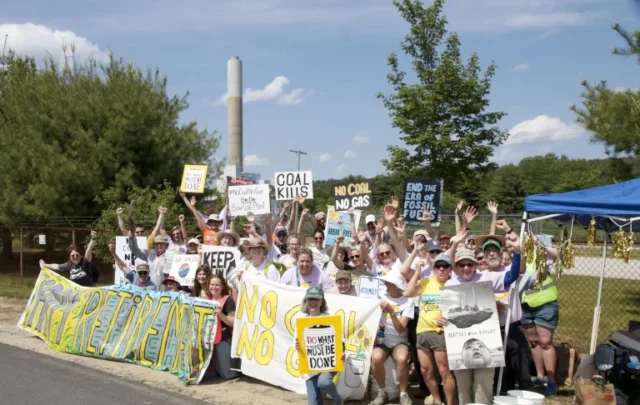When people look back nowadays to medieval philosophy, they often dismiss it with the derisive remark that it was concerned with debating “how many angels can dance on the head of a pin”. The sense is of an era whose thinkers engaged in sterile intellectual gymnastics founded on flawed premises. It’s an unfair characterization, which reveals more about the modern people who say it than the medieval objects of their contempt. Still, sometimes I wonder if there are aspects of our contemporary intellectual chitchat that might invoke angels-on-a-pin type dismissals from people in the future.
One candidate could be the notion that our civilization is on the brink of an energy transition from polluting fossil energy to clean renewable energy that will save it from the depredations of climate change, energy descent and other gathering crises. This is relevant to my present blog cycle concerning food synthesized industrially from microbes, because it’s clear that this technology will only be feasible long-term at scale with cheap and clean renewable energy at levels probably an order of magnitude, maybe even more, above existing global energy consumption. The main pushback of substance I’ve had to my book Saying NO to a Farm-Free Future is that this era of clean energy abundance indeed is upon us, making manufactured food feasible and confining my arguments for agrarian localism and a small farm future to the dustbin of history.
I doubt that, and in this post I’ll try to elucidate some of those doubts.
To frame the question in wider terms first, there have of course been civilizations before modern times that ultimately fell. It might be wise to learn some lessons from them, and not imagine that our present one is impervious. Our existing global, modern civilization got going around the 15th century, built initially upon intercontinental trade connections, sailboats, slavery, colonial conquest and plantation agriculture. I’ll call this ModCiv 1.0. We’re now living in a successor global modern civilization to ModCiv 1.0 built on fossil fuels, which I’ll call ModCiv 1.1.
The idea of an impending energy transition is that we can now ditch the fossil fuels imperilling our world through climate change and create another successor global modern civilization that looks a lot like ModCiv 1.1, but built on renewable, low-carbon energy – ModCiv 1.2.
Quite simply, I don’t think this is possible. The best hope (and I fear it’s a slender one) is to build a different kind of civilization, a solar civilization, which I’d hope would certainly use renewable forms of electricity generation to tap the sun’s energy, but would be unable to furnish primary energy at the fossil-assisted levels achieved by ModCiv 1.1, and would tap energy mostly via plants. I’ll call this SolarCiv 1.0.
SolarCiv 1.0 would have less energy freely available than we’re accustomed to in our present ModCiv 1.1, at least in the rich parts of it. Therefore, it would be fundamentally an agrarian civilization where production of key energy, soil fertility, food and other material necessities would be locally oriented. In my books A Small Farm Future and Saying NO to a Farm-Free Future, I’ve tried to start imagining what SolarCiv 1.0 might look like and what kind of problems it would face.
Originally, I’d planned to write a thoroughly researched and quantified analysis of renewable energy futures to substantiate my doubts about the feasibility of ModCiv 1.2. But life is short, and I think my time is better spent addressing myself to the more realistic scenarios of SolarCiv 1.0 than getting trapped into debating ModCiv 1.2 talking points. I’ve spent a lot of time substantiating the energetic implausibility of microbial food quantitatively, only to find people airily ignoring my analysis in favour of vague optimism about ModCiv 1.2 or even personal attacks on me. Maybe this is a clue that the debate isn’t really about numbers and material realities at all, but deeper beliefs about how we wish things to turn out – a question of eschatology more than evidence … or a question of angels and pins.
Anyway, I do provide some quantification in what follows, but I’ve decided to frame this post more in the form of a request. If the renewables proponents for ModCiv 1.2 (or RPs, as I shall call them – an acronym I recall from my rock-climbing days: a handy bit of tech to have in a sticky situation, but not something you’d really want to bet your life on) are sure we’re on the cusp of ModCiv 1.2, presumably they have some solid numbers to back this up, and in this post I’ll be asking to see those numbers and/or other evidence across various dimensions of the issue, not all of which are discussed as much as I believe they should be.
Some Energy Basics
So let’s get started. Figure 1 shows global primary energy consumption (in exajoules) since 1965 by energy type. To move from ModCiv 1.1 to ModCiv 1.2 the thick blue wodge of fossil energy needs to dwindle pretty much to zero in a matter of decades, while the thin slivers of other colours – principally, for various reasons, the yellow solar sliver – needs to expand and more or less take its place.
Figure 1: Global primary energy consumption
(Note: the underlying source for these figures and all others in this post is the Energy Institute’s Statistical Review of World Energy, https://www.energyinst.org/statistical-review).
As Figure 1 shows, this isn’t happening. People talk about ‘the energy transition’, but as yet it’s a future hope, not a present reality. There are some complications to this that I’ll come to in a moment. But it’s worth just pausing to look at the shape of the graph and contemplate the enormity of what needs to happen.
Since I got interested in this issue about a quarter of a century ago I’ve been watching the global fossil energy consumption climb year on year as shown in Figure 1 (barring the Covid and financial shocks), with people proclaiming all the while that the transition out of fossils and into renewables is eminently feasible and just around the corner. Which leads to my first question:
Q1: Giving reasons, state when you think a global transition out of fossil fuels will begin, and when will it end (transition completed)?
It’s worth noting incidentally that various papers proposing the feasibility of a transition to a completely renewable energy system (like this one and this one) seem to operate with a completion date of around 2100, which might be too late in view of climate and other dynamics. My punt is that at some point in the next few years we’ll probably see fossils plateauing or dropping a little, while the low carbon sources increase, and there will be a lot of cheerleading about the arrival of the energy transition. However, the arrival is less important than the departure of the fossils – if they don’t disappear, fast, year on year, we have a problem.
I said earlier that renewables need to expand to take the place of fossils ‘more or less’. ‘More or less’ because – as RPs like to point out – there’s a lot of waste heat with solid fuels that can be avoided with electrical alternatives (petrol engines vs electric engines, for example). Therefore, a solar civilization may not need to consume as much total energy to do the same work as a fossil-fuelled civilization.
But the problem with electricity is that you can’t store it (except through tricky subterfuges like turning it into chemical energy in batteries or in hydrogen or methanol, which come with their own costs, including energetic ones). Plus, renewable electricity availability fluctuates in the short and long term with the vagaries of wind and sun, meaning that you need to build a lot of energetically-inefficient storage or extra generating capacity which in good times is unnecessary, with energy wasted (‘curtailed’ in the jargon) – probably a bit of both.
Another issue is that while electricity is more efficient than fossils for some uses, for others it can be less efficient – particularly where the fossils act as chemical feedstocks as well as sources of energy. These uses are non-trivial in terms of the global economy, including things like manufacturing metal alloys, cement, plastics, fertilizer and other agrochemicals. And all this is before we’ve even begun to consider the extra electricity that would be required to produce manufactured food, which I calculated in Saying NO… could amount conservatively to about ten times the existing supply of solar electricity just to meet global protein needs, if that’s a route ModCiv1.2 wishes to pursue.
Yet another issue, albeit straying here from energy basics into geopolitics, is the impetus in poor countries with relatively low energy usages to increase their energy use as a means to improve social wellbeing. Not only does this seem ethically right, but if it’s thwarted there’s a good chance it’ll lead to global political instabilities that could challenge the basis of ModCiv 1.1 and its chances of a smooth transition to ModCiv 1.2.
Therefore, if the aim is to preserve a high-energy global civilization of the present kind, but with more evenly distributed energy use (thereby securing political stability), then total global energy use will probably need to be much higher than today’s, where regions like East Africa (primary energy consumption: 4.9 GJ per capita) sit alongside regions like North America (primary energy consumption: 235.6 GJ per capita).
So, putting all this together leads to Question 2:
Q2: In view of the relative electrical efficiencies and inefficiencies involved in a renewables based ModCiv 1.2, and also considering the increased energy demands of poor countries, what do you project as a viable global annual energy consumption in ModCiv 1.2 compared to the present global figure of 604 EJ?
Geopolitics
Since I just mentioned geopolitics, let’s consider that some more.
Table 1 lists the world’s ten biggest energy-consuming countries. I also give their proportionate reliance on fossil energy consumption, and their fossil energy production rankings. Between them, these ten countries account for 66% of global energy consumption (the top five account for 56%). To put that another way, the future of global decarbonization pretty much rests in the hands of five governments.
Table 1: Energy consumption/production by country
| Total primary energy consumption (EJ) | Fossil fuel consumption as % of all energy use | Oil production (country rank) | Gas production (country rank) | Coal production (country rank) | Solar generation growth rate per annum 2012-22 (%) | |
| China | 159.4 | 82 | 6 | 4 | 1 | 61 |
| USA | 95.9 | 81 | 1 | 1 | 4 | 37 |
| India | 34.5 | 88 | 22 | 23 | 2 | 46 |
| Russian Federation | 28.9 | 86 | 3 | 2 | 6 | 89 |
| Japan | 17.8 | 85 | – | – | 32 | 30 |
| Canada | 14.1 | 64 | 4 | 5 | 12 | 21 |
| Brazil | 13.4 | 50 | 9 | 30 | 25 | 167 |
| South Korea | 12.7 | 83 | – | 33 | 37 | |
| Germany | 12.3 | 76 | – | 44 | 11 | 9 |
| Iran | 12.2 | 99 | 8 | 3 | – | 100 |
I could write a lot of words about Table 1, but I’d like to hear what other people – particularly RPs – have to say about it. Trying to keep it quantitative, my question is this:
Q3: Given the global balance of political, economic and military power between the largest energy-consuming and energy-producing countries, what are your estimated odds for all of them transitioning to low-carbon energy sources within the next three decades?
No doubt there are different ways of interpreting the fact that most of these countries have increased their production of solar electricity disproportionately compared to the global annual average from 2012-22 of 29%, while the top five in particular have also generally increased their consumption of fossils. One reason could be that these countries are more interested in increasing their energy resilience than any great enthusiasm for transitioning out of fossil fuels as such. Maybe some of the positions taken at the recent COP28 meeting are consistent with this? In 2022, the world increased its solar generation by 29%, but 38% of that global increase occurred in China alone, a country uniquely placed to achieve it and which has some obvious reasons for trying to achieve it that aren’t especially consistent with ModCiv 1.2 goals.
It seems likely to me that there will be some hard geopolitics in the coming years around access to critical resources, energy chief among them. Smaller players in this global scene – like my home country, the UK – will likely be scrabbling for allies, and also for whatever local energy sources they can get their hands on, including any local fossil reserves. So, non-quantitatively –
Q4: What are the grounds for thinking that many countries will not open or re-open local fossil fuel resources in the context of future energy geopolitics?
Almost finally on this topic, a transition to renewables would involve a shift from the geopolitics of fossil energy location to the location of other critical minerals like lithium and copper, which are also unevenly distributed across the world.
Q5: Are there likely to be high costs or supply chain disruptions arising from monopolies in the supply of critical minerals for renewable energy?
Finally finally on this topic, one pushback I’ve had from RPs is that if we fail to transition to ModCiv 1.2 this won’t be because it’s technically unfeasible, but will only be because of political factors. To me, this is suggestive of the techno-determinism our thinking has become mired in. By the same token, Napoleon failed to become world emperor ‘only’ because of political factors. When it comes to the fate of human societies, political factors are the ‘only’ thing there is, pretty much.
Critical minerals
Talking of critical minerals as I was, let’s move straight to Q6 –
Q6: What will be the average annual financial and energetic cost in the long-term of furnishing the minerals necessary to transition to ModCiv 1.2 at the level specified in Q2 through mining and extraction of new material and through recycling existing material?
Just to expand on the question briefly, I see a lot of graphics online like this one purporting to show that the mineral requirements for renewables are much less than for fossil fuels, the implication apparently being that minerals are not a limiting factor to a renewable transition.
But that graphic is meaningless. For a start, it doesn’t indicate the absolute quantity of minerals that are available. Nor, assuming that enough minerals are available to support ModCiv 1.2, does it indicate the costs of extraction, smelting and processing them into the final products. A proper answer to Q6 is needed.
Grids
Given that ModCiv 1.2 will probably involve an increase in electricity consumption (subject to the answer to Q2) from its current level of 105 EJ to something equivalent or more likely considerably in excess of the current total global energy consumption of 604 EJ, this implies the need to build higher capacity electricity grids. And also probably to extend them into rural areas where the inhabitants previously relied on solid fuels. Either that, or amplify energy inequalities between grid-connected folks and rural off-grid people, which could be interesting politically. Anyway, bigger grids mean higher grid costs in terms of money, energy and materials, albeit offset against lower costs for fossil energy distribution.
The International Energy Agency says: “To achieve countries’ national energy and climate goals …. means adding or refurbishing a total of over 80 million kilometres of grids by 2040, the equivalent of the entire existing global grid …. At least 3 000 gigawatts (GW) of renewable power projects, of which 1 500 GW are in advanced stages, are waiting in grid connection queues – equivalent to five times the amount of solar PV and wind capacity added in 2022. This shows grids are becoming a bottleneck for transitions to net zero emissions.”
Q7: What would be the net costs (financial, energetic and material) of increased grid capacity and penetration, and of overcoming existing grid bottlenecks?
Q8: What would be the social and/or political implications of the geography of grid penetration?
Cost
I’d now like to take a closer look at the issue of cost. It’s arisen in several of the questions, and it’s also a favoured talking point of RPs along the lines that the cost of installing renewable generating capacity has plummeted, supposedly making ModCiv 1.2 now economically feasible in a way it previously wasn’t.
It could be unwise to assume that the cost of renewables will continue to fall. Yes, that’s been the case with technical innovations and with increasing supply as the proportion of solar electricity in the energy mix has climbed from a lowly 0.7% back in 2011 to fully 2.5% today. But material, technical and supply limits may kick in as that proportion makes the precipitous rise that will be required over the next few decades if we’re to achieve ModCiv 1.2.
One study estimates that most of the costs of a renewable transition will apply at the higher levels of renewable substitution – 70% of them occur in moving from 60 to 100% renewables. There are also costs involved in the recurrent decommissioning and replacement of old capacity which haven’t yet been fully figured into the relatively young industry. It seems that the rate of decline in the cost of new solar capacity is already beginning to slow and level out, while photovoltaic panel costs are increasing due to the rising price of polysilicon in China. Could these be straws in the wind for longer-term trends?
Q9: Giving reasons, estimate the cost trend for installing new renewable capacity worldwide if the global energy economy greatly increases solar electric capacity over the next few decades.
But what kind of cost? The cost of energy facilities is typically given in the form of a levelized cost, which is basically a version of what economists call ‘marginal costs’. In other words, they address the question of how much it would cost to install another kilowatt or megawatt of renewable generating capacity within the present energy economy. But that’s not the question before us in building ModCiv 1.2. The real question is what is the total cost of building it, or maybe what is the average annual cost of building it over the next few decades that remain available to us to build it.
I’ve already hinted in the previous discussion at many of the considerations that will have to go into that total cost figure. In summary, the total cost of a renewables transition will involve the cost of:
- Increasing renewable capacity worldwide, probably at the very least by installing new capacity equivalent to the entire present solar capacity of the world each and every year for the next 25 years – and probably quite a lot more to ensure it’s sufficient to cover seasonal cycles, curtailment etc.
- Disinvesting in and decommissioning existing fossil fuel infrastructures
- Creating cradle-to-grave renewable infrastructures from the installed renewable capacity: mining raw materials, manufacturing the generating equipment, decommissioning and replacing old equipment
- Increasing grid capacities and penetration
- Manufacturing critical materials currently reliant upon fossil hydrocarbons for energy or feedstocks, including metals, cement, fertilizer, agrochemicals and plastics
Figures for the levelized or marginal cost of installing new renewable generating capacity really don’t convey much useful information about this task, whereas figures for the total cost do. So:
Q10: Estimate the total cost of creating a mostly renewables based ModCiv 1.2 within a realistic timeframe encompassing all those cost pushes, and any other relevant ones.
A final point. However low the cost of renewable generation is, it’s unlikely ever to approach the cost of plain sunlight, which is zero. This establishes a cost hurdle that I doubt manufactured microbial food will ever surmount in any version of civilization, whether ModCiv 1.1, ModCiv 1.2 or SolarCiv 1.0.
Peer review: or, the return of the dancing angels
I haven’t seen many convincing efforts to answer Q10 in the energy literature. To be fair, it’s not an easy calculation to make, but it’s hard to take the RP case for ModCiv 1.2 very seriously until somebody has a decent go at it that charts a plausible course from here to there.
One person who’s had a go at it and concluded that there isn’t a plausible course is Simon Michaux, who I cited in my book. Some aspects of his analysis have been questioned, which is fair enough – people make mistakes, and there are almost always grounds for questioning aspects of every analysis. But some of the pushback he’s received – and I’ve received for citing him – strikes me as questionable in itself. Not so much a case of critiquing and refining the analysis as dismissing it so as to duck the awkward reality of Q10.
One of the criticisms of Michaux is that his analysis isn’t peer-reviewed. Now, I’m all in favour of peer review. I’ve both published and refereed peer-reviewed articles myself and I’ve sat on editorial boards of peer-reviewed journals. There’s a lot to be said for communities of scholars holding themselves to account in this way, and a peer-reviewed article does offer some basic level of quality assurance – a bit like buying an organically-certified product in a supermarket.
But the process isn’t magic. The fact that various scholars have opined in peer-reviewed articles that ModCiv 1.2 is possible doesn’t mean it’s going to happen. We have at most a few decades to implement it, in reality and on the ground, with a hell of a lot of photovoltaic panels, copper wiring and heavy industrial infrastructure that needs to be going in right now. After that, the possibility will most likely be out of our hands due to climate change and intractable geopolitics. And we haven’t even started down the road yet. At present, we only seem to be talking about it. I hear lots of talk along the lines that ‘the literature’ says ModCiv 1.2 is possible. But when you consult the literature, you read a lot of this kind of thing:
“All in all, there appears to be reason for moderate optimism that material criticalities will not represent an unsurmountable roadblock towards the transition to 100% RE systems. However, it is also clear that it will be a formidable challenge to ensure the timely availability of resources while simultaneously minimizing the negative impacts of extraction on humans and the environment. This needs to be a focus of upcoming research.”
I don’t particularly mean to criticise this paper but, at this late stage in the game of ModCiv 1.1, if where we’re at is only ‘moderate optimism’ in a whip round of opinion among experts who think formidable challenges are possibly surmountable but there’s a need for more research, then it’s surely plausible to think there are grounds for moderate pessimism about the prospects for ModCiv 1.2 and a need to switch focus to bringing SolarCiv 1.0 into being.
Are we merely imagining our way to the salvation of ModCiv 1.2 through a thicket of peer-reviewed opinion about the theoretical promise of solar electricity? If so, that brings us to:
Q11: How many PV panels can dance on the head of a pin?
New Current Reading
Michael Boxwell Solar Electricity Handbook (…appropriately/inappropriately enough)
Jennifer Grayson A Call To Farms
Manda Scott Any Human Power







